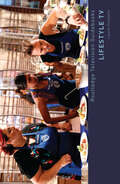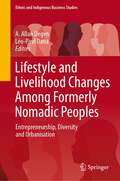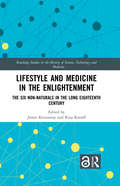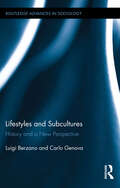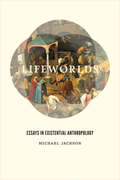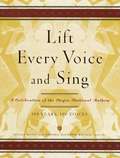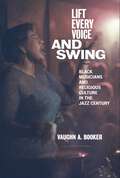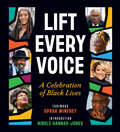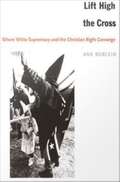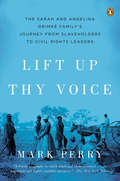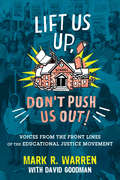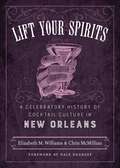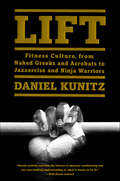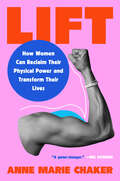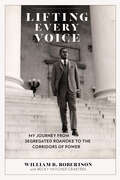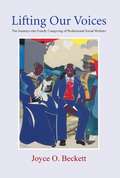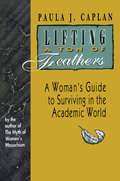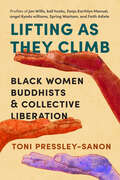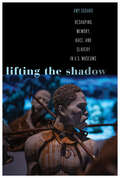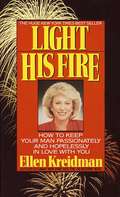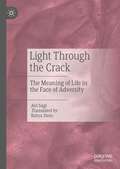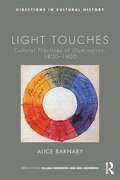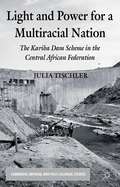- Table View
- List View
Lifestyle TV (Routledge Television Guidebooks)
by Laurie OuelletteFrom HGTV and the Food Network to Keeping Up With the Kardashians, television is preoccupied with the pursuit and exhibition of lifestyle. Lifestyle TV analyzes a burgeoning array of lifestyle formats on network and cable channels, from how-to and advice programs to hybrid reality entertainment built around the cultivation of the self as project, the ethics of everyday life, the mediation of style and taste, the regulation of health and the body, and the performance of identity and "difference." Ouellette situates these formats historically, arguing that the lifestyling of television ultimately signals more than the television industry's turn to cost-cutting formats, niche markets, and specialized demographics. Rather, Ouellette argues that the surge of reality programming devoted to the achievement and display of lifestyle practices and choices must also be situated within broader socio-historical changes in capitalist democracies.
Lifestyle and Livelihood Changes Among Formerly Nomadic Peoples: Entrepreneurship, Diversity and Urbanisation (Ethnic and Indigenous Business Studies)
by Léo-Paul Dana A. Allan DegenContemporary policymakers, as their predecessors, continue to view nomadic people as a weak minority, and their way of life and raising livestock as a backward and inefficient paradigm. Wherever nomads are not the dominant group, the trend to settle them continues even today as in the past. This book describes the changes forced upon formerly nomadic groups and how they still attempt to maintain their traditional, social, and cultural practices in their new settings. The book deals with the several modes of livelihood of these communities, including entrepreneurship, and demonstrates the impact of investment-oriented urbanization policies leading to eviction from ancestral lands, and hurdles for nomadic mobility, ultimately threatening their survival. The book illustrates how some groups like the Borana and the Maasai practice livelihood diversity and raise productive livestock, and how other groups migrate to urban centers in search of employment and remit money to family members left in the rural areas. The book aims to raise awareness among the research community, especially those who work on regional and demographic labor policies. It helps in understanding why society needs to help build business and livelihood strategies without harming the values of nomadic groups.
Lifestyle and Medicine in the Enlightenment: The Six Non-Naturals in the Long Eighteenth Century (Routledge Studies in the History of Science, Technology and Medicine)
by James Kennaway Rina KnoeffThe biggest challenges in public health today are often related to attitudes, diet and exercise. In many ways, this marks a return to the state of medicine in the eighteenth century, when ideals of healthy living were a much more central part of the European consciousness than they have become since the advent of modern clinical medicine. Enlightenment advice on healthy lifestyle was often still discussed in terms of the six non-naturals – airs and places, food and drink, exercise, excretion and retention, and sleep and emotions. This volume examines what it meant to live healthily in the Enlightenment in the context of those non-naturals, showing both the profound continuities from Antiquity and the impact of newer conceptions of the body.
Lifestyles and Subcultures: History and a New Perspective (Routledge Advances in Sociology #152)
by Luigi Berzano Carlo GenovaLifestyles and subcultures are tools through which people say – to themselves and to others – who they think they are, who they think they are similar to, and who they think they are different from. Lifestyles and subcultures are ways which people adopt to look at their own lives, and to try to keep together different roles, different practices and different realms which they are involved in. Lifestyles and subcultures are lenses through which we, as observers, analyze society, and orientate ourselves within it, looking for similarities and differences among individuals and collectivities which allow us to understand their thoughts and their actions. This book presents the main analytical approaches through which lifestyles and subcultures have been studied, and also proposes a new interpretative perspective. Today a growing panorama of social phenomena and processes possess intermediate characteristics with regard to those which in the past were identified either as lifestyles or as subcultures. The hypothesis is that consequently these phenomena could be explained and interpreted by means of an analytical framework developed by the intersection of these two perspectives, and the last part of the book is therefore devoted to the presentation of this innovative framework. This book provides new lenses and a fresh view to try to both grasp and understand a constantly-changing reality.
Lifetime Disadvantage, Discrimination and the Gendered Workforce
by Susan Malcolm Sargeant Bisom-RappLifetime Disadvantage, Discrimination and the Gendered Workforce fills a gap in the literature on discrimination and disadvantage suffered by women at work by focusing on the inadequacies of the current law and the need for a new holistic approach. Each stage of the working life cycle for women is examined with a critical consideration of how the law attempts to address the problems that inhibit women's labour force participation. By using their model of lifetime disadvantage, the authors show how the law adopts an incremental and disjointed approach to resolving the challenges, and argue that a more holistic orientation towards eliminating women's discrimination and disadvantage is required before true gender equality can be achieved. Using the concept of resilience from vulnerability theory, the authors advocate a reconfigured workplace that acknowledges yet transcends gender.
Lifetimes under Apartheid
by Nadine GordimerExcerpts from the works of Nadine Gordimer, Nobel Prize for Literature winner from South Africa.
Lifeworlds: Essays in Existential Anthropology
by Michael JacksonMichael Jackson's Lifeworlds is a masterful collection of essays, the culmination of a career aimed at understanding the relationship between anthropology and philosophy. Seeking the truths that are found in the interstices between examiner and examined, world and word, and body and mind, and taking inspiration from James, Dewey, Arendt, Husserl, Sartre, Camus, and, especially, Merleau Ponty, Jackson creates in these chapters a distinctive anthropological pursuit of existential inquiry. More important, he buttresses this philosophical approach with committed empirical research. Traveling from the Kuranko in Sierra Leone to the Maori in New Zealand to the Warlpiri in Australia, Jackson argues that anthropological subjects continually negotiate imaginatively, practically, and politically their relations with the forces surrounding them and the resources they find in themselves or in solidarity with significant others. At the same time that they mirror facets of the larger world, they also help shape it. Stitching the themes, peoples, and locales of these essays into a sustained argument for a philosophical anthropology that focuses on the places between, Jackson offers a pragmatic understanding of how people act to make their lives more viable, to grasp the elusive, to counteract external powers, and to turn abstract possibilities into embodied truths.
Lift Every Voice and Sing: A Celebration of the Negro National Anthem; 100 Years, 100 Voices
by Julian Bond Sondra Kathryn Wilson"A group of young men in Jacksonville, Florida, arranged to celebrate Lincoln's birthday in 1900. My brother, J. Rosamond Johnson, and I decided to write a song to be sung at the exercise. I wrote the words and he wrote the music. Our New York publisher, Edward B. Marks, made mimeographed copies for us and the song was taught to and sung by a chorus of five hundred colored school children. "Shortly afterwards my brother and I moved from Jacksonville to New York, and the song passed out of our minds. But the school children of Jacksonville kept singing it, they went off to other schools and sang it, they became teachers and taught it to other children. Within twenty years it was being sung over the South and in some other parts of the country. Today, the song, popularly known as the Negro National Hymn, is quite generally used. "The lines of this song repay me in elation, almost of exquisite anguish, whenever I hear them sung by Negro children. " —James Weldon Johnson, 1935 Pasted into Bibles, schoolbooks, and hearts, "Lift Every Voice and Sing," written by J. Rosamond Johnson and James Weldon Johnson in 1900, has become one of the most beloved songs in the African American community—taught for years in schools, churches, and civic organizations. Adopted by the NAACP as its official song in the 1920s and sung throughout the civil rights movement, it is still heard today at gatherings across America. James Weldon Johnson's lyrics pay homage to a history of struggle but never waver from a sense of optimism for the future—"facing the rising sun of our new day begun, let us march on till victory is won. " Its message of hope and strength has made "Lift Every Voice and Sing" a source of inspiration for generations. In celebration of the song's centennial, Julian Bond and Sondra Kathryn Wilson have collected one hundred essays by artists, educators, politicians, and activists reflecting on their personal experiences with the song. Also featuring photos from historical archives, Lift Every Voice and Sing is a moving illustration of the African American experience in the past century. With contributors including John Hope Franklin, Jesse Jackson, Maya Angelou, Norman Lear, Maxine Waters, and Percy Sutton, this volume is a personal tribute to the enduring power of an anthem. "Lift Every Voice and Sing" has touched the hearts of many who have heard it because its true aim, as Harry Belafonte explains, "isn't just to show life as it is but to show life as it should be. "
Lift Every Voice and Swing: Black Musicians and Religious Culture in the Jazz Century
by Vaughn A. BookerWinner of the 2022 Gustave O. Arlt Award in the Humanities, award by by the Council of Graduate SchoolsExplores the role of jazz celebrities like Ella Fitzgerald, Cab Calloway, Duke Ellington, and Mary Lou Williams as representatives of African American religion in the twentieth centuryBeginning in the 1920s, the Jazz Age propelled Black swing artists into national celebrity. Many took on the role of race representatives, and were able to leverage their popularity toward achieving social progress for other African Americans. In Lift Every Voice and Swing, Vaughn A. Booker argues that with the emergence of these popular jazz figures, who came from a culture shaped by Black Protestantism, religious authority for African Americans found a place and spokespeople outside of traditional Afro-Protestant institutions and religious life. Popular Black jazz professionals—such as Ella Fitzgerald, Cab Calloway, Duke Ellington, and Mary Lou Williams—inherited religious authority though they were not official religious leaders. Some of these artists put forward a religious culture in the mid-twentieth century by releasing religious recordings and putting on religious concerts, and their work came to be seen as integral to the Black religious ethos. Booker documents this transformative era in religious expression, in which jazz musicians embodied religious beliefs and practices that echoed and diverged from the predominant African American religious culture. He draws on the heretofore unexamined private religious writings of Duke Ellington and Mary Lou Williams, and showcases the careers of female jazz artists alongside those of men, expanding our understanding of African American religious expression and decentering the Black church as the sole concept for understanding Black Protestant religiosity. Featuring gorgeous prose and insightful research, Lift Every Voice and Swing will change the way we understand the connections between jazz music and faith.
Lift Every Voice: A Celebration of Black Lives
by Oprah Winfrey Nikole Hannah-Jones&“When we lift every voice, we forge a deep and enduring connection to the past—and carve a tunnel of hope to a brighter future for us all.&” -Oprah Winfrey &“This book, above all else, is a reminder of where we have been and the debt we owe to those who came before. These Americans have not passed the torch, but are clasping it with us, urging us to continue the work alongside them,&”-Nikole Hannah-Jones More than 50 elders share their remarkable experiences of being Black in America in a collection of powerful photographs and interviews For so long, too many stories that reveal what it means and feels like to be Black in America have been overlooked outside Black communities. After these long years of racial reckonings and nascent awakenings, Lift Every Voice presents interviews with the oldest generation of Black Americans about their lives, their experiences, and the wisdom that can carry all of us to a better future. The 54 fascinating individuals—civil rights activists, hometown heroes, celebrities, and many others—include: • Andre de Shields, an actor, director, and choreographer who discusses the essential values and lessons his parents taught him • Clarice Freeman, an educator and community leader in Houston, Texas who speaks about how to live a long and fulfilling life • Fred Gray, a civil rights lawyer who represented Rosa Parks and Claudette Colvin, also featured in the book, against disorderly conduct charges for their refusal to give up their bus seats to white passengers • Patti LaBelle a singer/songwriter who shares her thoughts on aging and her career as an internationally celebrated powerhouse singer • Faye Wattleton, a reproductive rights activist and the first African American and youngest president of Planned Parenthood who recounts her experience as a nurse and midwife in the 1960s The insightful interviews were conducted by a brilliant team, many of whom are rising Black journalists from historically Black colleges and universities, and the portraits were shot by a talented group of next generation Black photographers. Lift Every Voice is named after the James Weldon Johnson poem and hymn "Lift Every Voice and Sing," which is often referred to as the "Black national anthem." Lift Every Voice is both a testament to the strength of the elders&’ stories and a triumphant beginning for a new generation of Black journalists and photographers.
Lift High the Cross: Where White Supremacy and the Christian Right Converge
by Ann BurleinBoth the Christian right and right-wing white supremacist groups aspire to overcome a culture they perceive as hostile to the white middle class, families, and heterosexuality. The family is threatened, they claim, by a secular humanist conspiracy that seeks to erase all memory of the nation's Christian heritage by brainwashing its children through sex education, multiculturalism, and pop culture. In Lift High the Cross Ann Burlein looks at two groups that represent, in one case, the "hard" right, and in the other, the "soft" right--Pete Peters's "Scriptures for America" and James Dobson's "Focus on the Family"--in order to investigate the specific methods these groups rely on to appeal to their followers. Arguing that today's right engenders its popularity not by overt bigotry or hatred but by focusing on people's hopes for their children, Burlein finds a politics of grief at the heart of such rhetoric. While demonstrating how religious symbols, rituals, texts, and practices shape people's memories and their investment in society, she shows how Peters and Dobson each construct countermemories for their followers that reframe their histories and identities--as well as their worlds--by reversing mainstream perspectives in ways that counter existing power relations. By employing the techniques of niche marketing, the politics of scandal, and the transformation of political issues into "gut issues" and by remasculinizing the body politic, Burlein shows, such groups are able to move people into their realm of influence without requiring them to agree with all their philosophical, doctrinal, or political positions. Lift High the Cross will appeal to students and scholars of religion, American cultural studies, women's studies, sociology, and gay and lesbian studies, as well as to non-specialists interested in American politics and, specifically, the right.
Lift Up Thy Voice
by Mark PerryIn the late 1820s Sarah and Angelina Grimké traded their elite position as daughters of a prominent white slaveholding family in Charleston, South Carolina, for a life dedicated to abolitionism and advocacy of women's rights in the North. After the Civil War, discovering that their late brother had had children with one of his slaves, the Grimké sisters helped to educate their nephews and gave them the means to start a new life in postbellum America. The nephews, Archibald and Francis, went on to become well-known African American activists in the burgeoning civil rights movement and the founding of the NAACP. Spanning 150 eventful years, this is an inspiring tale of a remarkable family that transformed itself and America.
Lift Us Up, Don't Push Us Out!: Voices from the Front Lines of the Educational Justice Movement
by David Goodman Mark R. WarrenParents, young people, community organizers, and educators describe how they are fighting systemic racism in schools by building a new intersectional educational justice movement.Illuminating the struggles and triumphs of the emerging educational justice movement, this anthology tells the stories of how black and brown parents, students, educators, and their allies are fighting back against systemic inequities and the mistreatment of children of color in low-income communities. It offers a social justice alternative to the corporate reform movement that seeks to privatize public education through expanding charter schools and voucher programs. To address the systemic racism in our education system and in the broader society, the contributors argue that what is needed is a movement led by those most affected by injustice--students of color and their parents--that builds alliances across sectors and with other social justice movements addressing immigration, LGBTQ rights, labor rights, and the school-to-prison pipeline. Representing a diverse range of social justice organizations from across the US, including the Chicago Teachers Union and the Genders and Sexualities Alliance Network, the essayists recount their journeys to movement building and offer practical organizing strategies and community-based alternatives to traditional education reform and privatization schemes. Lift Us Up! will outrage, inform, and mobilize parents, educators, and concerned citizens about what is wrong in American schools today and how activists are fighting for and achieving change.
Lift Your Spirits: A Celebratory History of Cocktail Culture in New Orleans (The Southern Table)
by Elizabeth M. Williams Chris McmillianThe Sazerac, the Hurricane, and the absinthe glass of Herbsaint are among the many well-known creations native to New Orleans's longstanding drinking culture. But more than vehicles for alcohol, the cocktails and spirits that complement the city's culinary prowess are each a token of its history. In every bar-side toast or street-corner daiquiri you can find evidence of the people, politics, and convergence of ethnicities that drive the story of the Crescent City.In Lift Your Spirits: A Celebratory History of Cocktail Culture in New Orleans, Elizabeth M. Williams, founder and director of the Southern Food and Beverage Institute, and world-renowned bartender Chris McMillian illuminate the city's open embrace of alcohol, both in religious and secular life, while delving into the myths, traditions, and personalities that have made New Orleans a destination for imbibing tourists and a mecca for mixologists.With over 40 cocktail recipes interspersed among nearly three hundred years of history, a sampling of premier cocktail bars in New Orleans, and a glossary of terms to aid drink making and mixing, Lift Your Spirits honors the art of a good drink in the city of good times.
Lift: Fitness Culture, from Naked Greeks and Acrobats to Jazzercise and Ninja Warriors
by Daniel KunitzA fascinating cultural history of fitness, from Greek antiquity to the era of the “big-box gym” and beyond, exploring the ways in which human exercise has changed over time—and what we can learn from our ancestors.We humans have been conditioning our bodies for more than 2,500 years, yet it’s only recently that treadmills and weight machines have become the gold standard of fitness. For all this new technology, are we really healthier, stronger, and more flexible than our ancestors?Where Born to Run began with an aching foot, Lift begins with a broken gym system—one founded on high-tech machinery and isolation techniques that aren’t necessarily as productive as we think. Looking to the past for context, Daniel Kunitz crafts an insightful cultural history of the human drive for exercise, concluding that we need to get back to basics to be truly healthy.Lift takes us on an enlightening tour through time, beginning with the ancient Greeks, who made a cult of the human body—the word gymnasium derives from the Greek word for “naked”—and following Roman legions, medieval knights, Persian pahlevans, and eighteenth-century German gymnasts. Kunitz discovers the seeds of the modern gym in nineteenth-century Paris, where weight lifting machines were first employed, and takes us all the way up to the game-changer: the feminist movement of the 1960s, which popularized aerobics and calisthenics classes. This ignited the first true global fitness revolution, and Kunitz explores how it brought us to where we are today.Once a fast-food inhaler and substance abuser, Kunitz reveals his own decade-long journey to becoming ultra-fit using ancient principals of strengthening and conditioning. With Lift, he argues that, as a culture, we are finally returning to this natural ideal—and that it’s to our great benefit to do so.
Lift: How Women Can Reclaim Their Physical Power and Transform Their Lives
by Anne Marie ChakerFrom a professional bodybuilder and longtime Wall Street Journal reporter, a manifesto on how women can radically change their lives by tapping into their innate physical powerWhen Wall Street Journal reporter Anne Marie Chaker discovered bodybuilding as a hobby in midlife, she was recovering from a series of traumas, including postpartum depression, the end of her marriage, and the sudden death of her father. By throwing herself into strength training and stretching her body beyond what she imagined to be its limits, she began to regain confidence. Slowly, she challenged the deeply entrenched body insecurities she realized she&’d long held, and her life changed in ways she never could have imagined.In Lift, Chaker explores the forces that have led generations of women to internalize the message that they should make themselves smaller and explains why, instead, building muscle not only creates long lasting health, but also empowers us. Along the way, she highlights research that dismantles the conventional story of women&’s bodies. As Chaker argues, strength training can help women find true power and confidence that goes far beyond how we look: it can dramatically shift how we move through the world, reshape how we respond to setbacks, and transform how we see our value. And science shows that increasing muscle mass can help protect women&’s bodies from the effects of aging. Most important, it rewrites the message we send the next generation once and for all and will help girls step into their power from a young age.Bridging narrative storytelling with empowering and actionable takeaways, including advice on how to start a training program, Lift is a rallying cry and inspiring guide to help women to get stronger for life.
Lifting Every Voice: My Journey from Segregated Roanoke to the Corridors of Power
by William B. RobertsonBill Robertson was one of our greatest pioneers and a tireless advocate for racial justice. One of his final acts was the completion of his memoirs. Lifting Every Voice reveals how the advances made during his lifetime were no foregone conclusion; without the passionate efforts of real people, our present could have been very different.The survivor of a traumatic childhood in the Green Book South, and the witness to his father's rage over racial inequity, Robertson rose above an oppressive environment to find a place within the system and, against extreme odds, effect change. He was the first Black man to run for the Virginia General Assembly, and as a teacher, the first to help integrate a white school in Roanoke. He became the first Black decision-maker in any southern governor’s office, appointed by Virginia governor Linwood Holton in 1970. In a state controlled by segregationist Democrats, Holton was the first Republican governor since Reconstruction, and his government was pivotal in its commitment to move the state away from nearly a century of segregationist policies. Bill Robertson was an inner-circle member of this historic administration. His account of its challenges and hard-won victories tells us much about that critical era.Robertson went on to serve five presidents, heading the Peace Corps office in Kenya and later serving as deputy assistant secretary of state for African affairs. As a public servant he worked on both sides of the aisle, in a way almost inconceivable in today’s polarized society, collaborated with the Jaycees to build a camp for children with mental disabilities in Virginia, and eventually focused his support on Black Lives Matter in his eighties—because there is still so far to go.
Lifting Our Voices: The Journeys Into Family Caregiving of Professional Social Workers
by Joyce O. BeckettLifting Our Voices is the only book to explore the dual roles of professional social workers who are also family caregivers and the only collection on caregiving in which the majority of contributors are African American. After discussing the relevant literature, Lifting Our Voices vividly and sensitively presents the caregiving experiences of ten professional social workers. Using professional and theoretical knowledge and skills, each contributor draws implications for various levels of social work and human service interventions. These poignant descriptions and analyses recount both the frustrations and barriers of negotiating social service agencies and other institutions and the joys and triumphs of family caregiving. Lifting Our Voices frankly discusses how a professional education either prepares or fails to equip an individual with the skills for successful intervention on behalf of a loved one. Contributors hail from rich and varied backgrounds, revealing the importance of age, ethnicity, gender, marital status, and gerontological expertise in the practice of family caregiving. These essays explore situations rarely reported on in the literature, such as caregivers and care recipients who represent the lifespan from preschool to retirement. Lifting Our Voices graphically describes types of caregiving that are seldom discussed, including simultaneous caregiving to multiple family members and reciprocal and sequential caregiving, thus broadening and refining the very concepts of "caregiving" and "family."
Lifting a Ton of Feathers: A Woman's Guide For Surviving in the Academic World
by Paula J. CaplanLifting a Ton of Feathers is not only a survival guide, it is also a destroyer of academic myths about women's career chances in the university, and a revelation of the catch-22 positions in which women find themselves. Caplan demonstrates that while many women believe that when they fail it is their fault, their fate is more likely to be sealed by their encounter with the male environment, and by the manner in which they are tossed about by it. She aims to help women avoid self-blame and understand the real sources of their problems. Readers will find the information about the mine-field of academia for women infuriating, but the means of telling it highly entertaining. Women account for more than half of all undergraduate students in the US and Canada, yet they make up only 10 per cent of faculty members at the level of full professor. What happens to women between freshman level, the tenure track, and the ensuing following professional years that keeps them out of the highest levels of academia? Paula Caplan is herself a veteran of the academic career struggle, and she sets out to explore this question with not only her own observations but also those of many women whom she has interviewed, and with a strong backing of established research. With these tools she provides a clear-eyed assessment of what women who have embarked on an academic career, and those who are considering it, may expect. Forewarned is forearmed, and Caplan presents a list of the forms that the maleness of the environment take: two of these are the conflict between professional and family responsibilities, and sexual harassment. In addition, her book offers advice on practical techniques of how to prepare a curriculum vitae, how to handle job interviews, and how to apply for promotions and tenure. A final chapter is a unique checklist which serves two purposes: to provide guidance in a search for a woman-positive institution and to give suggestions for ways individual women, and women in groups, can work to improve the situation at their own institutions.
Lifting as They Climb: Black Women Buddhists and Collective Liberation
by Toni Pressley-SanonThe lives and writings of six leading Black Buddhist women—Jan Willis, bell hooks, Zenju Earthlyn Manuel, angel Kyodo williams, Spring Washam, and Faith Adiele—reveal new expressions of Buddhism rooted in ancestry, love, and collective liberation.Lifting as They Climb is a love letter of freedom and self-expression from six Black women Buddhist teachers, conveyed through the voice of author Toni Pressley-Sanon, one of the innumerable people who have benefitted from their wisdom. She explores their remarkable lives and undertakes deep readings of their work, weaving them into the broader tapestry of the African diaspora and the historical struggle for Black liberation. Black women in the U.S. have adapted Buddhist practice to meet challenges ranging from the injustices of the Jim Crow South to sexual violence, social discrimination, and bias within their Buddhist communities. Using their voices through the practice of memoir and other forms of writing, they have not only realized their own liberation but carried forward the Black tradition of leading others on the path toward collective awakening.
Lifting the Shadow: Reshaping Memory, Race, and Slavery in U.S. Museums (Genocide, Political Violence, Human Rights)
by Amy SodaroLifting the Shadow: Reshaping Memory, Race, and Slavery in U.S. Museums examines a small but significant wave of new U.S. memorial museums that focus on slavery and its ongoing violent legacies, including the Smithsonian National Museum of African American History and Culture, Montgomery’s Legacy Museum: From Enslavement to Mass Incarceration, and Greenwood Rising, which commemorates the 1921 Tulsa Race Massacre. These museums are challenging historical narratives of slavery and race by placing racial oppression at the center of American history and linking historical slavery to contemporary racial injustice, but they have opened in a period marked by growing racial tension, white nationalism, and political division. Sodaro examines how the violence of U.S. slavery and its lasting legacies is negotiated in these museums, as well as their potential to contribute to the development of a more critical historical memory of race in the U.S. at this particularly volatile sociopolitical moment.
Light His Fire: How to Keep Your Man Passionately and Hopelessly in Love With You
by Ellen KreidmanLessons on how to become the only woman he'll ever want or need
Light Through the Crack: The Meaning of Life in the Face of Adversity
by Avi SagiAn epidemic such as COVID-19 challenges life’s very order and meaning, interferes in our relations with others, and breaks apart our routine. It raises many questions in the realms of ethics, politics, theology, psychology, and beyond. Perhaps more than anything else, it prompts us to ponder: what does this encounter with widespread anguish and distress imply about the human self-perception as sovereign rulers of Earthly life?In this book, renowned thinker Avi Sagi explores the existential matters brought to the philosophical fore by the pandemic. He shows how we, when thrown into the terror of a crisis, carry the traditions, values, ideals, hopes, failures, and habits that constitute our lives, all shaping the way we grapple with questions seemingly resolved. We may then find that the crack that opens up at times of sorrow can also be a moment of discovery. Sagi analyzes various ways of confronting the crack now at the heart of our existence. What emerges is a clear normative statement: We are not only what we were but also what we can be, and we can create a world of meaning by standing together with others.
Light Touches: Cultural Practices of Illumination, 1800-1900 (Directions in Cultural History)
by Alice BarnabyLight Touches: Cultural Practices of Illumination, 1800-1900 explores how urban lives in the nineteenth century were increasingly touched by innovations in the technologies and aesthetics of illumination. Dramatic changes in qualities of light – and darkness – became acutely palpable to the human sensorium; using, seeing, feeling, and being in light were now matters of intense personal and cultural concern. Light gave meaningful vitality to the period’s material culture, and light itself became something to be perceptually consumed. Over the course of six chapters Alice Barnaby traces how light was used in amateur artistic pastimes, interior design and clothing fashions, spectacular public amusements, volatile street demonstrations, and art gallery designs. From these previously unexplored examples a more complex history of light in the period emerges. Society’s fascination with illumination, its desire to work with it and make meaning from it gave rise to a distinctly new set of cultural practices. Through these practices unexpected discoveries about the modern world were revealed. Light proved to be instrumental in everyday acts of experimentation and imaginative enquiry. Barnaby offers an intervention into the dominant scholarly narrative of the nineteenth century which traditionally reads modernity as synonymous with the formation of a spectacular, disembodied visuality. Light Touches, in contrast, returns vision to the body and foregrounds the actively felt - as well as seen - sensation of light. In coming to understand these cultural practices of illumination, the book reconsiders many assumptions about nineteenth-century modernity.
Light and Power for a Multiracial Nation
by Julia Tischler'Modernisation' was one of the most pervasive ideologies of the twentieth century. Focusing on a case study of the Kariba Dam in central-southern Africa and based on an array of primary sources and interviews the book provides a nuanced understanding of development in the turbulent late 1950s, a time when most colonies moved towards independence.
